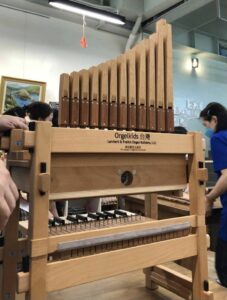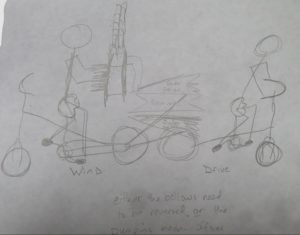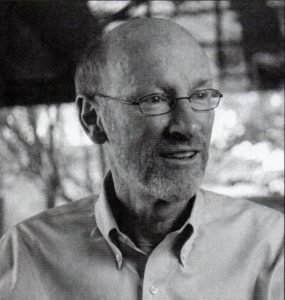安斯巴赫(Ansbach)的威格勒布(Wiegleb)管風琴和萊比錫聖詠前奏曲CD
『The Wiegleb-organ in Ansbach and the CD of Leipzig Chöral』
專訪德國國立斯圖加特音樂與表演藝術大學,管風琴、大鍵琴教授與指揮家Jörg Halubek。
Special interview with Jörg Halubek, professor of organ and harpsichord at the University of Music and Performing Arts in Stuttgart. He won the highest honor at the 2004 Bach competition in Leipzig. Currently, he’s in the process of using the early and survived instruments to record the complete works of Bach. This is a musical marathon testing the technique, perseverance, and creativity of an organ performer. We thank him for taking time out of his incredibly busy schedule to share his Bach project and his teaching experience with Orgelkids Taiwan.
1. 德國有許多出名的管風琴,相較之下,這座管風琴並不是非常廣為人知的。你為何選擇用這座樂器來錄製萊比錫聖詠前奏曲CD?可否介紹這座樂器的一些特點,以及你特有的想法?這些特點是否會影響你的錄音?
「這座樂器已經完成修復而且受到相當的看重。我曾受邀參與安斯巴赫的「巴 哈週」,之後這座琴的聲音一直在我耳中迴盪。原本的建造者威格勒布出身於艾爾福特(Erfurt)的製琴傳統,與托氏(Trost)的實驗風格相當接近,具有多種巴哈非常喜歡的色彩。以出身於巴哈的圖林根(Thueringen)地區的管風琴建造者而言,威格勒布或許算是最現代的。巴哈住在萊比錫的晚期,修訂了他在威瑪時期所寫的18首聖詠前奏曲鉅作,我們可以在同一份手稿中發現三重奏與〈從至高處我今降臨〉(Vom Himmel hoch)的卡農變奏曲。因此,這個曲集與巴哈的晚期有關連,也是我帶這個曲集到安斯巴赫去的緣由。這座琴同樣是1739年的巨型管風琴,氣流量很低,有德國管風琴最早的增風琴腳踏板,非常多種不同的8呎和4呎音栓,因此具有「真情風格」和一絲浪漫情懷,音色平穩,色彩豐富,與西爾伯曼(Silbermann)或希爾德布蘭(Hildebrandt)的美學完全不同」。
“This instrument is a complete very respected reconstruction. As I´ve been guest at the Bachwoche Ansbach this instrument was always in my ears. The original builder of that organ: Wiegleb comes from the Erfurt tradition, close to Trost experimental style with a lot of colors which Bach liked so much – As an organ builder from the Bach Region of Thueringen Wiegleb is maybe the most modern. In the late Leipzig year Bach revised his collection of his huge choral preludes from the Weimar period, in the same manuscript we find the trios and the canonic Variations on Vom Himmel hoch – so this collection is connected to Bachs late time which was my link to go to Ansbach with that collection. Again a huge organ from 1739, a low wind level, the first swell box of german organs and a huge variety of 8´and 4´ stops makes this organ “empfidnsam” and a bit romantic. Smooth sound, lots of colors – a complete different aesthetic from Silbermann or Hildebrandt.”
2. 我們知道德國有好幾種類型的管風琴,有北德、西爾伯曼、南德。這座管風琴屬於哪一類?與巴哈和他的管風琴音樂有什麼特別的關係?
「它源出於艾爾福特,是典型的巴哈地區。我想在巴哈的時代,有一種比較傳統的管風琴音響,就如我們可以聽到的西爾伯曼管風琴(巴哈大部分的作品都無法用這種琴演奏,因為腳鍵盤沒有d1),還有很多創新的概念已經步入早期浪漫派了。從巴哈對於新式管風琴的描述中可以看到,他似乎比較喜歡托氏和希爾德布蘭所代表的現代走向。我的錄音計畫想要呈現出不同管風琴建造家的十種特點,這些名家都在巴哈的管風琴音樂中佔有一席之地。當然要有一站是西爾伯曼管風琴,明年我會到弗萊貝格(Freiberg)和勒塔(Rötha)錄製威瑪時期晚期和在柯登(Cöthen)譜寫的作品」。
“The roots are in Erfurt, so typical Bach region. I think in Bachs time there was a more traditional way of organ sound – as we find in Silbermann organs (where most of Bachs pieces cannot be played, as the d1 is missing in the pedal) and a lot of creative ideas which leads already in the early romantic. As we know from Bach’s reports of new instruments, he seemed to prefer the more modern direction represented by Trost or Hildebrandt. In my project I want to give ten portraits of different organ builders who played a role in Bach’s organ cosmos. Of course one stop will be Silbermann, next year I’ll go to Freiberg an Rötha to record pieces of the late Weimar period and from Cöthen.”
3. 如果這座管風琴在錄音時有一些音栓不盡理想,你會如何解決這樣的問題?
「答案與呂娜堡管風琴一樣: (19世紀管風琴建造家所做的改變,產生了某些音質的平衡差度。我在選擇音栓配置時,經常會帶著一個學生,我坐在教堂裡,學生彈琴,我們就用行動電話溝通要如何調整音栓組合。)
不過這座琴重建得很好,你可以任意做組合,只需要確認在教堂空間裡達到均衡即可」。
“Same answer like in Lüneburg. But this organ is were well reconstructed, you can combine everything, you have just to check the balance in church.”
4. 在這座教堂裡的音響效果如何?與前兩座教堂有何不同嗎?這次錄音最大的挑戰是什麼呢?
「瓦爾特爾斯豪森(Waltershaus)的管風琴完全沒有殘響,就算觀眾席全空也一樣;而呂娜堡完全相反,肯定有到6秒的殘響。安斯巴赫則介於二者之間,是很舒服的音響效果,這會改變演奏的方式。我們的錄音技術不會編輯音響效果,因此瓦爾特爾斯豪森還是很乾、呂娜堡還是殘響豐富,得用演奏方法加以處理,但是在殘響長的音響環境中就把彈奏的速度減半、全部都用斷音來彈,這也沒有意義。這當然會改變樂曲的特性。我愈來愈相信,巴哈的音樂是為了新教教堂典型的乾式環境所寫的,你可以想像《聖翰受難曲》開頭的聖詠,用濕式音響效果wet acoustic的話,根本什麼都聽不懂」。
“Waltershaus was completely dry, no reverb even in empty chuch, Lüneburg the total opposite, surely 6 seconds of reverb. Ansbach is some kind in the middle, quite comfortable acoustic. The Acoustic changes the way of playing – in our recording technique we don’t edit the acoustic – so Waltershausen stays dry and Lüneburg stays wet. You have to react with your playing, but it doesn’t make sense to play half tempo and everything staccato in a wet acoustic. This changes of course the character of pieces. More and more I’m convinced that Bach’s music was written for the typical dry protestant churches – imagine the opening choir of the St. Johan passion – already in a bit of wet acoustic one doesn’t understand anything.”
5. 小管風琴曲集》和萊比錫的《聖詠前奏曲》都是根據四聲部聖詠即興編曲,可否請你為我們說明二者之間的關係與差異?現今的管風琴家可以從這兩個作品得到怎樣的學習?
「《小管風琴曲集》的特殊之處在於,《聖詠曲》的女高音用四分音符完整寫出來,當然是用許多技巧,從卡農到裝飾法……所謂「萊比錫聖詠前奏曲」(很久之前譜寫的)是代表許多不同類型的長篇聖詠前奏曲,當中包含間奏曲等,是速度較慢的聖詠曲,就像是《鍵盤練習曲第三集》(Clavierübing III )一樣,裡面有例如三重奏這種非常現代的曲式,也有像聖詠主題模仿曲這類17世紀特有的形式。但你說得完全正確,這些樂曲看起來會遵循演奏者的本能,你當然可以找出一些高階即興作品的實例。而《鍵盤練習曲第三集》的結構如此高階,就比較像是現代性的作品了,而巴哈只把這個曲集付梓,或許就代表這個意義」。
“The special thing in Orgelbuchlein is, that the Choral comes complete in the soprano as written in the Choral-book, in quarter notes – of course with a lot of techniques, from Canon to Ornamentation… The so called “Leipzig”Chorals (which are from much earlier period) represent a lot of different types of longer Choralpreludes with interludes etc. – Choral in slower tempo etc… in a way – like Claverübing III – we have a collection of very modern forms like trio to very 17th inspired forms like the Choral-Ricercar. But you are totally right, the pieces seem to follow the instincts of a player and you could take some pieces as examples for improvisation on high level of course. Clavierübung III instead has such a high level of construction that it seems more like a composition in modern sense – that Bach printed only this Collection is maybe a signal n the same direction.”
6. 你在安斯巴赫工作和居住的感受如何?這個城市和附近地區是什麼樣子?在錄音的時候會讓你有特別的感受嗎?
「我曾六度應邀參與安斯巴赫的巴哈週,演奏大鍵琴和擔任指揮,在那裡就像是回到家一樣的熟悉,我也很喜歡那個地區的生活和好友。安斯巴赫是一位邊疆總督的居住地,有莊嚴雄偉的義大利式建築代表作品,使這座小城的景觀包含了城堡和橘園。巴哈週每兩年舉開10天,非常值得推薦」。
“As I’ve been 6 times as Guest at the Bach-Festival in Ansbach, with recitals as Harpsichordist and Conductor I really feel like home in Ansbach and enjoy the time and the friendly people of that Region. As Ansbach was the residence of a margrave, impressive and representative Italian architecture gives the picture of that small city with castle and orangeries. The Bach-Festival takes place all two years for 10 days – and it’s a highly recommendation.”
訪談:柯可心 (就讀於斯圖加特國立音樂與表演藝術大學,學習大鍵琴、西方早期音樂Early Music、與管風琴)





